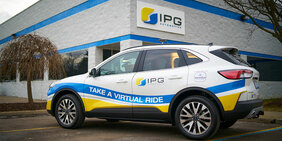Closing the gap between HIL tests and real test driving with the vehicle-in-the-loop (VIL) method! Our US colleagues are going on a tour across the States with their brand-new demo vehicle to give our customers the chance to experience the technology up close.
With a 2020 Ford Escape Titanium, our team from IPG Automotive USA will be going on tour starting March 24. They will first head to our customers in California, giving them the opportunity to see the advantages of physical tests in a real vehicle within a virtual environment and directly give the method a try.
The VIL method enables testing and validation of ADAS functions with a physical vehicle on a physical road but with traffic and pedestrians that are generated using a virtual environment. Among others, ACC and AEB functions can be tested with the new demo vehicle.
By using the VIL method, the sensors mounted on the physical vehicle do not respond to the real environment but receive information from the virtual world of the CarMaker simulation. This enables tests on parking lots or test tracks without any physical traffic.
Typical use cases for VIL include tests of park assist, lane change or emergency brake assist systems, with or without pedestrian and cyclist detection, evasive steering assist systems as well as the analysis of complex autonomous driving functions within traffic flowing in the virtual world. It is also possible to carry out NCAP tests with this method.
The tour is combined with one-day workshops in which customers are shown and get to discover potentials for improvement in the ADAS and ACC development process from model-in-the-loop to vehicle-in-the-loop.
From California, the tour will be continued across the Midwest and later along the East Coast.
